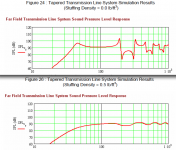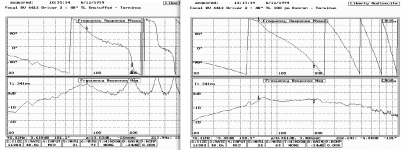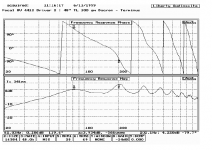Maybe im confused on the fiberfill. Am I suppose to use poly fill like this
http://i332.photobucket.com/albums/m322/tjniels/Gardner Project/DSCF0249.jpg
Or am i suppose to just line the walls with this ?
http://product-image.tradeindia.com/00373336/b/1/Polyfill-Roll.jpg
After seeing your latest drawing im thinking its the first option.
Originally I was thinking it was the roll and I would line the entire cabinet with it
http://i332.photobucket.com/albums/m322/tjniels/Gardner Project/DSCF0249.jpg
Or am i suppose to just line the walls with this ?
http://product-image.tradeindia.com/00373336/b/1/Polyfill-Roll.jpg
After seeing your latest drawing im thinking its the first option.
Originally I was thinking it was the roll and I would line the entire cabinet with it
Last edited:
Thanks. Another question is can I cover the duct throat with some screen wire to keep spiders and whatever out of there without impeding the sound any?
Hi,
Are you talking about the opening to the room? That's the mouth, or the terminus. Anyway, a grill should work, just something you have to try.
Regards,
Are you talking about the opening to the room? That's the mouth, or the terminus. Anyway, a grill should work, just something you have to try.
Regards,
Thanks for pointing out Martin King’s work, very useful information.Hi Art,
No, I don't. I go by bjorno's analysis using the Martin King MathCAD worksheets. My experiments with TL speakers were a long time ago, but I assume the stuffing to be of similar importance.
Regards,
I can see damping definitely being useful for eliminating the periodic peaks when using a TL above the subwoofer range, or for eliminating a LF resonant peak that would be difficult (or expensive) to do using passive crossovers or filters.
The stuffing described by Martin King reduces the LF response by anywhere from 2 to 6 dB, depending on the fill weight and frequency.
With DSP as cheap as it is, and driver , enclosure and space at a premium, it seems a waste to throw away half to 3/4 of the sub’s power into warming up polyfill.
The graphs below, from Martin’s work, make it obvious the huge amounts of power thrown away.
Attachments
Thanks for pointing out Martin King’s work, very useful information.
I can see damping definitely being useful for eliminating the periodic peaks when using a TL above the subwoofer range, or for eliminating a LF resonant peak that would be difficult (or expensive) to do using passive crossovers or filters.
The stuffing described by Martin King reduces the LF response by anywhere from 2 to 6 dB, depending on the fill weight and frequency.
With DSP as cheap as it is, and driver , enclosure and space at a premium, it seems a waste to throw away half to 3/4 of the sub’s power into warming up polyfill.
The graphs below, from Martin’s work, make it obvious the huge amounts of power thrown away.
My entire system uses active xover and equal at the preamp level if that helps any.
I would suggest correcting frequency response problems with your crossover slopes and EQ rather than throwing away the power into fill, take away 3-6 dB and you might as well use a much smaller sealed cabinet.My entire system uses active xover and equal at the preamp level if that helps any.
That said, a judicious placement of a small amount of fill could correct a specific peak without throwing away useful power.
I'll be experimenting with that myself shortly, have some drivers on their way, and a huge cabinet with some holes that need filling...
Hi Art,
"... judicious placement of a small amount of fill..."
I agree, that's the key, and experimenting.
I doubt that for PA service you would want to "throw away useful power", but in a home theater environment it could come in handy to be able to tune the low end of the response to the room while at the same time getting rid of the big peaks and valleys that have to color the sound even after extensive electronic filtering.
According to bjorno an enclosure like this should only be filled half-way, and even then there should be "judicious" tapering of the stuffing density. I feel the stuffing is needed to get the highest sound quality out of this type of enclosure. Even with a tapped horn, the judicious placement of acoustic lining seems to improve the response, and consequently the sound quality.
It'll be great to see what you come up with in your experimentations, as you have extensive experience, and the test equipment to measure it correctly.
Regards,
"... judicious placement of a small amount of fill..."
I agree, that's the key, and experimenting.
I doubt that for PA service you would want to "throw away useful power", but in a home theater environment it could come in handy to be able to tune the low end of the response to the room while at the same time getting rid of the big peaks and valleys that have to color the sound even after extensive electronic filtering.
According to bjorno an enclosure like this should only be filled half-way, and even then there should be "judicious" tapering of the stuffing density. I feel the stuffing is needed to get the highest sound quality out of this type of enclosure. Even with a tapped horn, the judicious placement of acoustic lining seems to improve the response, and consequently the sound quality.
It'll be great to see what you come up with in your experimentations, as you have extensive experience, and the test equipment to measure it correctly.
Regards,
Hello Oliver,
I was just about to glue the baffle in and I wanted to double check a measurement before I do it.
The beginning of the mouth(terminus) is 3.09in (interior measurement). At the other end the drawing calls for 6.4in but an external measurement. I just want to confirm that the interior measurement is actually 5.68in before I glue.
I was just about to glue the baffle in and I wanted to double check a measurement before I do it.
The beginning of the mouth(terminus) is 3.09in (interior measurement). At the other end the drawing calls for 6.4in but an external measurement. I just want to confirm that the interior measurement is actually 5.68in before I glue.
Hi,
Yes, you are correct (5.680" [14.4cm]). I'll change the location of the dimension in the drawing.
Regards,
Yes, you are correct (5.680" [14.4cm]). I'll change the location of the dimension in the drawing.
Regards,
Yep...Adding lining or stuffing can dramatically cut efficiency if too much is used. For Pro audio or high output cabs, heavy use is a no go. Some amount used minimally can also make a large improvement in cleaning up cabinet resonances though. IMHO this is the best use of it. Large cabs always have resonances in the bass range due to the long dimensions involved and they can ring or honk and color the sound in a noticeable and bad way. A moderate amount of damping or stuffing can make a big improvement cleaning these up with only a very modest sacrifice in efficiency. Unfortunately really the only way to determine the right amount to use is through measurements and trial and error.
As usual YMMV.
As usual YMMV.
Hi,
"...the only way to determine the right amount to use is through measurements and trial and error."
That's why it is so important to get the removable access panels right.
Regards,
"...the only way to determine the right amount to use is through measurements and trial and error."
That's why it is so important to get the removable access panels right.
Regards,
Hi,
Yes, you are correct (5.680" [14.4cm]). I'll change the location of the dimension in the drawing.
Regards,
Ok I will glue the other end at 5.68in (interior) later on this afternoon
Hi,
"...the only way to determine the right amount to use is through measurements and trial and error."
That's why it is so important to get the removable access panels right.
Regards,
I cut access panels on both sides of the box yesterday. I got a new rabbit bit for the router so I could make 1/2 inch lips.
Any recommendations on a mic that I can use for tuning the flattest response? Is this one a decent one to get? Dayton Audio OmniMic Precision Measurement System 390-790 I will use it for tuning everything, not just bass.
Looks like a decent system for a fair price, and the calibration availability is a great thing.Any recommendations on a mic that I can use for tuning the flattest response? Is this one a decent one to get? Dayton Audio OmniMic Precision Measurement System 390-790 I will use it for tuning everything, not just bass.
There are far cheaper mics available, but without calibration you don't really know if the mic is accurate- I spent weeks of frustration thinking my designs were anemic, only to find the mic response (on a $1500 test set 😡) was rolled off in the bottom end, 6 dB down at 35 Hz, 10 dB down at 20 Hz..
You would not have that problem with the above system.
Art
EQ instead of properly damping a Quarter-Wave design for home use?
Why adding a chain of electronics that do more harm than enhancing the SQ already built in:
😱You are ...not... designing a traditional TL that MJK:s pictures depict,i.e. almost completely stuffed to allow a use up until a kHz.
You are designing a T-TQWT sub that needs to be stuffed as previously suggested for home use and not a second should for this purpose should SPL be traded from a smooth BW(IMO).
Damping(The Main delayed Pulse) should always be applied where the place of origin is(are) in a quarter-wave design like this is.
The Pre-Pulse that is that is added to the Main-Pulse has almost a near blameless FR,needs no damping or EQ at all.
Tweak one and the other will suffer with almost reciprocal FR dips and peaks as they are separated in time..
IMO your T-TQWT will have blameless FR errors in the pass-band but if your room play havoc with the stationary FR I recommend you to use more subs i.e. no EQ:s at all.
Follow TB46 advises instead...+ just use an ordinary (plate) amp with built in HPF and LPF and you are all set...
b🙂
My entire system uses active xover and equal at the preamp level if that helps any.
Why adding a chain of electronics that do more harm than enhancing the SQ already built in:
😱You are ...not... designing a traditional TL that MJK:s pictures depict,i.e. almost completely stuffed to allow a use up until a kHz.
You are designing a T-TQWT sub that needs to be stuffed as previously suggested for home use and not a second should for this purpose should SPL be traded from a smooth BW(IMO).
Damping(The Main delayed Pulse) should always be applied where the place of origin is(are) in a quarter-wave design like this is.
The Pre-Pulse that is that is added to the Main-Pulse has almost a near blameless FR,needs no damping or EQ at all.
Tweak one and the other will suffer with almost reciprocal FR dips and peaks as they are separated in time..
IMO your T-TQWT will have blameless FR errors in the pass-band but if your room play havoc with the stationary FR I recommend you to use more subs i.e. no EQ:s at all.
Follow TB46 advises instead...+ just use an ordinary (plate) amp with built in HPF and LPF and you are all set...
b🙂
Hello, I have two questions this morning.
First question is, The center board (baffle?) is about 0.70 inches too short. The way this came about is I put a full 19 x 12.56 for the board that has the mouth/terminus. I will route the mouth with a follower bit for a perfect cut. The reason for this is because I did like the three inch gaps on each side, not a big deal and its easily fixed 🙂
The problem is, when I went to make the baffle 0.70 shorter I took it from the opposite end of the speaker.
The way it sits in the box the board is the correct size. What is not right the woofer holes are not all the way up against the corner. Instead they are 0.70" from the corner of the box.
Im not one to half way to anything and if this will affect the sound, i will gladly cut a new board to make it EXACT. I have not glued this board and whatever you decide will be done across all 4 boxes. Its easy to fix now.
So will this affect the sound?
First question is, The center board (baffle?) is about 0.70 inches too short. The way this came about is I put a full 19 x 12.56 for the board that has the mouth/terminus. I will route the mouth with a follower bit for a perfect cut. The reason for this is because I did like the three inch gaps on each side, not a big deal and its easily fixed 🙂
The problem is, when I went to make the baffle 0.70 shorter I took it from the opposite end of the speaker.
The way it sits in the box the board is the correct size. What is not right the woofer holes are not all the way up against the corner. Instead they are 0.70" from the corner of the box.
Im not one to half way to anything and if this will affect the sound, i will gladly cut a new board to make it EXACT. I have not glued this board and whatever you decide will be done across all 4 boxes. Its easy to fix now.
So will this affect the sound?
Last edited:
Hi 2MuchRiceMakesMeSick,
"...the woofer holes are not all the way up against the corner. Instead they are 0.70" from the corner of the box."
I'm not sure that I get what you mean, there is a 0.742" gap between the frame of the woofer and S1 in the drawing. Moving the drivers 0.7" closer to the mouth-or further away-should not make an audible difference.
Regards,
"...the woofer holes are not all the way up against the corner. Instead they are 0.70" from the corner of the box."
I'm not sure that I get what you mean, there is a 0.742" gap between the frame of the woofer and S1 in the drawing. Moving the drivers 0.7" closer to the mouth-or further away-should not make an audible difference.
Regards,
I'd agree, sounds like a filler piece should be glued in and some sealant applied and no one but us will know the difference.Hi 2MuchRiceMakesMeSick,
"...the woofer holes are not all the way up against the corner. Instead they are 0.70" from the corner of the box."
I'm not sure that I get what you mean, there is a 0.742" gap between the frame of the woofer and S1 in the drawing. Moving the drivers 0.7" closer to the mouth-or further away-should not make an audible difference.
Regards,
Please excuse my drawings, I am not an artist.
Your drawing called for this arrangement.

Instead my baffle looks like this.

When I went to make the side board (terminus) and made it all one peice I had to shorten it one board length so it maintained the 57.403 measurement. Instead of cutting the red from the board, i cut the green which moved the woofers 0.7 inches closer to the fold
Your drawing called for this arrangement.

Instead my baffle looks like this.

When I went to make the side board (terminus) and made it all one peice I had to shorten it one board length so it maintained the 57.403 measurement. Instead of cutting the red from the board, i cut the green which moved the woofers 0.7 inches closer to the fold
- Status
- Not open for further replies.
- Home
- Loudspeakers
- Subwoofers
- Suggestions Creating Subwoofer Box(s) - 56 cuft available


